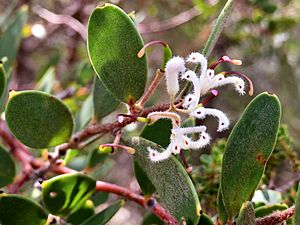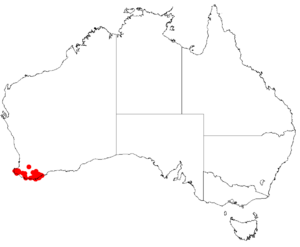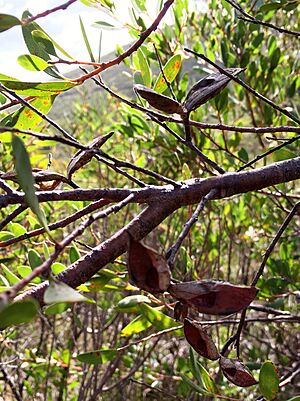Woolly-flowered hakea facts for kids
Quick facts for kids Woolly-flowered hakea |
|
|---|---|
 |
|
| Hakea lasiantha in the Stirling Range National Park | |
| Scientific classification | |
| Genus: |
Hakea
|
| Species: |
lasiantha
|
 |
|
| Occurrence data from AVH | |
The Hakea lasiantha, also called the woolly-flowered hakea, is a type of shrub. It belongs to the Proteaceae plant family. This plant grows naturally only in a specific area. That area is along the south coast of Western Australia. You can find it in the South West and Great Southern regions.
Contents
What it Looks Like
This shrub grows straight up and is usually dense and rounded. It can reach a height of about 0.6 to 3 meters (2 to 10 feet).
Flowers and Leaves
The Hakea lasiantha blooms from May to September. It produces white flowers that grow in groups where the leaves meet the stem. These flowers have a woolly look. Their parts are white or yellowish-brown, and they have a deep red style.
The leaves of this plant are flat. They are shaped like an ellipse or an egg, wider at the top. They are usually about 3 to 6 centimeters (1.2 to 2.4 inches) long. They are also about 0.7 centimeters (0.3 inches) wide. Young leaves and small branches are covered in rusty, woolly hairs.
Fruit
The fruit of the Hakea lasiantha is smooth and shaped like a narrow ellipse. It is typically 2.5 to 3 centimeters (1 inch) long. The fruit has only a small, slight beak.
How it Got its Name
The plant Hakea lasiantha was first officially described in 1830. This was done by a Scottish botanist named Robert Brown (botanist, born 1773).
The name lasiantha comes from ancient Greek words. "Lasios" means "shaggy" and "anthos" means "flower". This name refers to the woolly look of the flowers.
Where it Grows
This plant likes to grow in low, wet areas. You can find it from the Stirling Range to Albany. It also grows along the coast towards Ravensthorpe.
It prefers sandy loam and gravel soils. It grows in heathlands and scrublands. The plant likes a spot that drains water well and gets plenty of sunshine. It can also handle salty winds from the ocean. This plant can be a good shade tree and windbreak. It can also tolerate frost.
Conservation Status
The Hakea lasiantha is currently classified as "not threatened" by the government of Western Australia. This means it is not in danger of disappearing.


